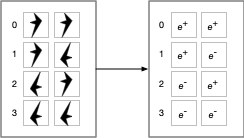The Universe Inside
Let us replace distinguishable objects with objects that distinguish themselves:

Then the physical operation that determines if two elements are equal is:

As shown in the previous post, e+ (the positron and its behavior) and e- (the electron and its behavior) are the behaviors assigned to the labels "true" and "false". One could swap e+ and e-. The physical system would still exhibit consistent logical behavior. In any case, this physical operation answers the question "are we the same?", "Is this me?", because these fundamental particles are self-identifying.
From this we see that logical behavior - the selection of one item from a set of two - is fully determined behavior.
In contrast to logic, nature features fully undetermined behavior where a selection is made from a group at random. The double-slit experiment shows the random behavior of light as it travels through a barrier with two slits and lands somewhere on a detector.
In between these two options, there is partially determined, or goal directed behavior where selections are made from a set of choices that lead to a desired state. It is a mixture of determined and undetermined behavior. This is where the problem of teleology comes in. To us, moving toward a goal state indicates purpose. But what if the goal is chosen at random? Another complication is that, while random events are unpredictable, sequences of random events have predictable behavior. Over time, a sequence of random events with tend to its expected value. We are faced with having to decide if randomness indicates no purpose or hidden purpose, agency or no agency.
In this post, from 2012, I made a claim about a relationship between software and hardware. In the post, "On the Undecidability of Materialism vs. Idealism", I presented an argument using the Lambda Calculus to show how software and hardware are so entwined that you can't physically take them apart. This low-level view of nature reinforces these ideas. All logical operations are physical (all software is hardware). Not all physical operations are logical (not all hardware is software). Computing is behavior and the behavior of the elementary particles cannot be separated from the particles themselves. If we're going to choose between idealism and physicalism, it must be based on a coin flip2.
If computers are built of logic "circuits" then computer behavior ought to be fully determined. But when we add peripherals to the system and inject random behavior (either in the program itself, or from external sources), we get non-logical behavior in addition to logic. If a computer is a microcosm of the brain, the brain is a microcosm of the universe.
[1] Quarks have fractional charge, but quarks aren't found outside the atomic nucleus. The strong nuclear force keeps them together. Electrons and positrons are elementary particles.
[2] Dualism might be the only remaining choice, but I think that dualism can't be right. That's a post for another day.

